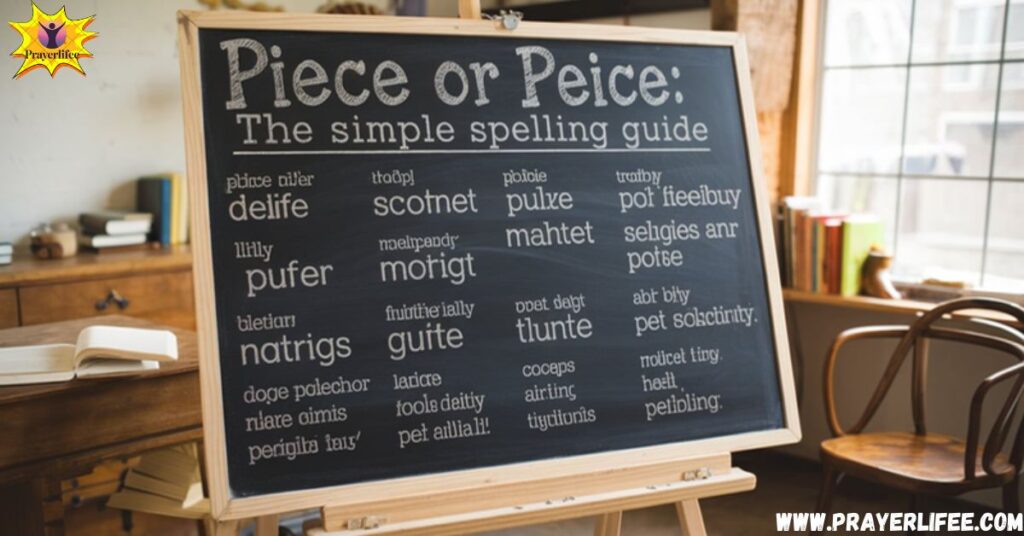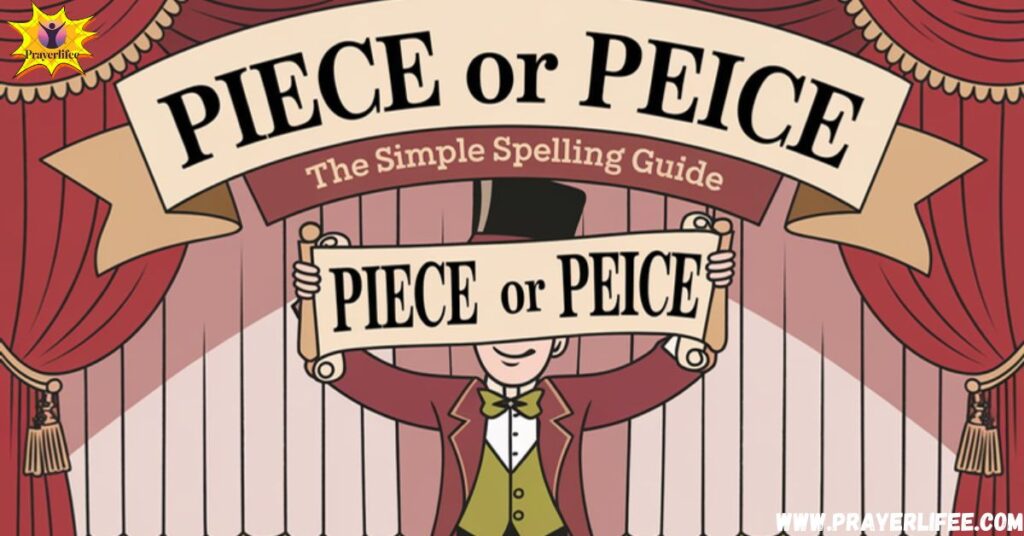“Piece or Peice”: The Simple Spelling Guide is here to help you understand the correct spelling of the word “piece.” Many people mistakenly spell it as “peice.” This guide will clear up the confusion and help you get it right every time.
Have you ever been unsure whether to write “piece” or “peice”? It’s a common mistake, and you’re not alone. With a simple explanation and a few easy tricks, you’ll be able to remember the correct spelling.
Mastering the correct spelling of “piece” is important for clear communication. It’s used in everyday language, from describing a portion of something to talking about art. This guide will help you avoid misspellings and improve your writing.
Understanding the Correct Spelling: “Piece or Peice”
When it comes to the words “piece” and “peice,” the correct spelling is “piece.” This confusion often arises because these two words are pronounced the same way. The phonetic similarity between “piece” and “peice” is one of the main reasons people mistakenly write “peice” instead of the correct spelling “piece.” It’s easy to understand how someone could think that the correct form should follow the familiar “I before E” rule, but the truth is this rule does not apply in the case of “piece.”
The reason for this misspelling lies in the complexity of English spelling and the way we apply spelling rules. The “I before E” rule works in many cases (e.g., “believe” or “grieve”), but there are notable exceptions, and “piece” is one of them. The “I before E” rule is a general guideline, but it is not always applicable to every word.
Definition and Meaning

The word “piece” refers to a portion or part of something. It is often used to describe something that has been separated from a larger whole. For example, you might refer to a “piece of cake,” a “piece of paper,” or even a “piece of art.” The meaning of the word can change depending on the context in which it’s used.
“Piece” can also be used in more abstract ways, such as when someone says “a piece of advice” or “a piece of knowledge.” In these cases, it refers to a small fragment or a portion of something that is less tangible but still valuable. It is important to remember that regardless of how it is used, the correct spelling is always “piece” and not “peice.”
Key Characteristics of “Piece”
The word “piece” is an essential part of the English language, used across many contexts and fields. It’s often used to describe physical objects, like a piece of furniture or a piece of bread. But it’s not limited to only tangible items; “piece” can also describe non-physical things like a piece of advice or a piece of music. The versatility of the word makes it one of the most common terms in the English language. Whether you are talking about objects, ideas, or even abstract concepts, “piece” is a highly flexible word that adapts to many situations.
Understanding the correct usage of “piece” in different contexts will help you avoid mistakes and use the word appropriately in your own writing. For example, in the sentence “She gave me a piece of advice,” “piece” refers to a portion or bit of advice. Similarly, “a piece of music” refers to a specific composition. It’s important to remember that these uses of the word should always be spelled as “piece,” not “peice.”
Etymology and History of “Piece”
The origins of the word “piece” go back several centuries, and understanding its etymology can help you better understand why it’s spelled the way it is today. The word “piece” comes from the Vulgar Latin word petia, which meant a portion or fragment of something. From there, it was adopted into Old French as piece, which also meant a part or portion.
When the word entered the English language, it was first used in Middle English. In fact, during the early Middle English period, the word was often spelled as pece or pese. It wasn’t until later that the modern spelling “piece” became standard.
By understanding the word’s history, it becomes clear why “piece” is the correct form today, and why other spellings like “pece” or “pese” were common before. This historical development of the word highlights how language evolution and changes in spelling over time lead to the standardized forms we use in modern English.
Read More: Understanding “Princess’ or Princess’s”:
Origins in Latin and Old French
The word “piece” can be traced back to Vulgar Latin, where petia was used to describe a part or portion of something. This Latin word made its way into Old French as piece, where it took on the same meaning. By the time the word entered Middle English, it had undergone some spelling changes, but the basic concept remained the same: a part of something.
The Latin influence on the word is important because it shows how the English language borrowed words from Latin and adapted them. Over time, English adopted many terms from Latin, particularly in the fields of law, science, and literature. The word “piece” is just one example of how Latin-based words became part of the English vocabulary.
Adoption into Middle English
As English evolved from Old English into Middle English, many words, including “piece,” underwent spelling and grammatical changes. The word “piece” was originally written as pece or pese in Middle English, but over time, these forms evolved into the modern spelling we use today: “piece.” This change in spelling wasn’t uniform, as English spelling was not standardized at the time.
The development of standardized spelling didn’t happen until the advent of the printing press in the 15th century. As books and other written materials became more widely available, spelling began to be regularized, and the spelling “piece” eventually became the preferred form.
Modern Usage and Versatility
In modern English, “piece” is used in a wide variety of contexts. The word is flexible and can refer to both tangible and intangible items. For instance, in everyday life, you might talk about a “piece of cake,” a “piece of paper,” or a “piece of furniture.” However, in more abstract contexts, you might say “a piece of advice,” “a piece of news,” or “a piece of music.”
The word is also used in idiomatic expressions like “a piece of the action” or “a piece of the puzzle,” which convey figurative meanings. This wide range of usage makes “piece” an essential word in the English language, one that writers and speakers rely on in many different contexts.
A Global Perspective
While the word “piece” is an important part of English, similar words can be found in other languages as well. In French, “pièce” means a part or portion, and in Spanish, “pieza” has the same meaning. These words have similar roots in Latin and share much of the same meaning. However, the misspelling of “piece” as “peice” is primarily an issue in English, and it’s important to recognize this as an example of how language confusion can lead to mistakes in spelling.
In other languages, spelling rules might be more rigid, and the correct spelling of words is usually more predictable. English, however, is full of exceptions, and this is why mastering spelling accuracy in English requires more than just memorizing rules.
Everyday Usage of “Piece”
“Piece” is a word that you will encounter frequently in everyday English. You might ask for a “piece of cake” at a birthday party or discuss “a piece of advice” in a conversation. The word is also commonly used in professional and academic contexts, such as when referring to a “piece of writing” or a “piece of research.”
In art and literature, “piece” is often used to refer to a work of creation, like a “piece of art” or a “literary piece.” Understanding how to use “piece” correctly in these contexts is important for ensuring that your writing is both clear and professional.
The Common Error: “Peice”
One of the most common spelling mistakes in English is writing “peice” instead of “piece.” The reason for this mistake is often due to phonetic similarity—both words sound the same, which leads people to assume that the spelling should follow the “I before E” rule. However, as previously mentioned, the “I before E” rule does not apply in this case, and “peice” is simply an incorrect spelling.
This misspelling is widespread and can be seen in both casual writing, such as text messages, and formal writing, such as essays or reports. It’s important to learn the correct spelling of “piece” to avoid misspellings and grammar mistakes in your work.
Why Do People Misspell “Piece”?

There are several reasons why people misspell “piece” as “peice.” First, as already discussed, the phonetic similarity of the words contributes to this common error. People often assume that since the two words sound the same, their spelling should follow the same pattern.
Second, the “I before E” rule is ingrained in many people’s minds from an early age. Because “piece” follows a different pattern, it’s easy to make the mistake of applying this rule incorrectly. Lastly, typing errors and cognitive overload—when we type too quickly or are distracted—can also contribute to the misspelling.
Examples of Common Errors
Here are some common examples of the misspelling of “piece” as “peice”:
- “I need a peice of paper to write my notes.”
- “This is a great peice of art.”
- “He gave me a peice of advice.”
In all these cases, the correct spelling should be “piece,” not “peice.” These are examples of common spelling mistakes that many people make, but once you understand the rule, it becomes easier to avoid them in your own writing.
Why Spelling Accuracy Matters
Spelling accuracy is crucial for effective communication. Correct spelling ensures that your writing is clear and that your ideas are easily understood. Misspelled words can confuse readers, leading to misunderstandings. In professional settings, poor spelling can damage your credibility and give the impression that you are careless or unprofessional.
Furthermore, spelling errors increase the cognitive load on readers, making it harder for them to focus on the actual content of your message. Inaccurate spelling, such as writing “peice” instead of “piece,” forces readers to pause and decode your message, which can disrupt the flow of communication.
Tools and Strategies for Correct Spelling

To avoid making mistakes like spelling “peice” instead of “piece,” you can use various tools and strategies. One of the most common tools is spell checkers, which are available in many word processing programs, such as Microsoft Word, Google Docs, or Grammarly. These tools can automatically detect and highlight spelling errors, making it easier for you to correct them before finalizing your writing.
In addition to spell checkers, you can also use grammar tools like Grammarly or ProWritingAid to help you spot errors and improve your writing. These tools not only help you catch spelling mistakes but also suggest improvements in sentence structure, grammar, and style.
Another strategy is to develop word spelling mnemonics to help you remember tricky spellings. For instance, to remember the correct spelling of “piece,” you can use a mnemonic like “A pie is in a piece.” This simple trick can help you recall the correct spelling every time.
Practical Tips for Avoiding Spelling Errors in “Piece or Peice”
To avoid making common spelling errors like “peice,” here are some practical tips:
- Use Spell Checkers: Always use a spell checker to catch spelling mistakes.
- Leverage Grammar Tools: Use grammar tools like Grammarly to ensure spelling accuracy.
- Proofread Your Work: Always double-check your writing before submitting it.
- Practice Regularly: The more you practice spelling correctly, the easier it becomes.
- Keep a Spelling Journal: Write down commonly misspelled words and review them regularly.
- Learn from Mistakes: When you make a mistake, take note of it and learn how to avoid it in the future.
Conclusion: Mastering “Piece or Peice”
In conclusion, mastering the correct spelling of “piece” and avoiding the misspelling “peice” is essential for clear and effective communication. By understanding the reasons behind phonetic spelling errors, applying spelling tips and tricks, and using writing tools to improve accuracy, you can ensure that your writing is both professional and easy to understand.
Whether you are writing a personal email or a professional report, taking the time to get your spelling right will make a big difference in the clarity and effectiveness of your communication.

